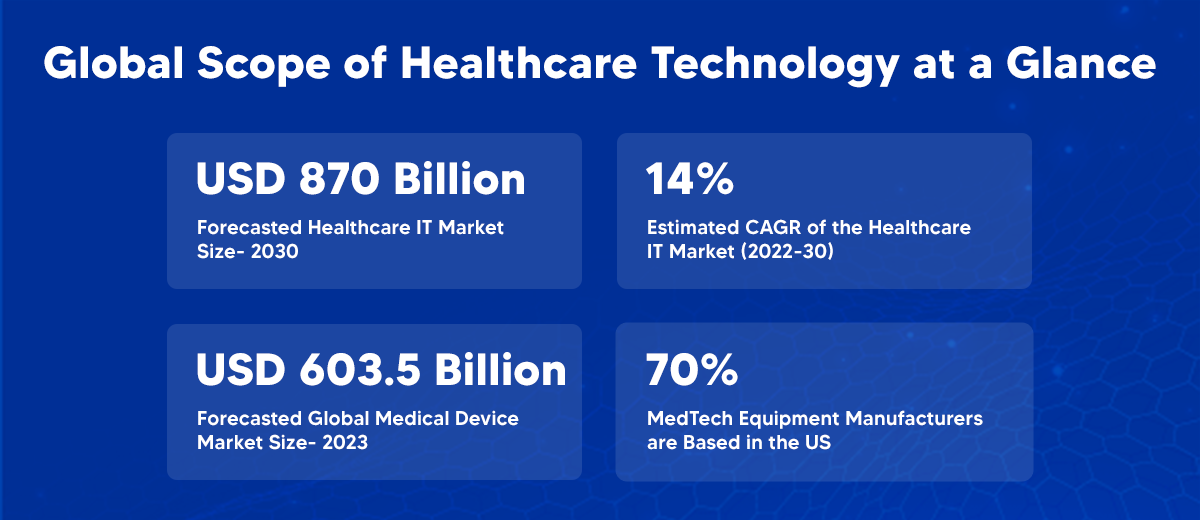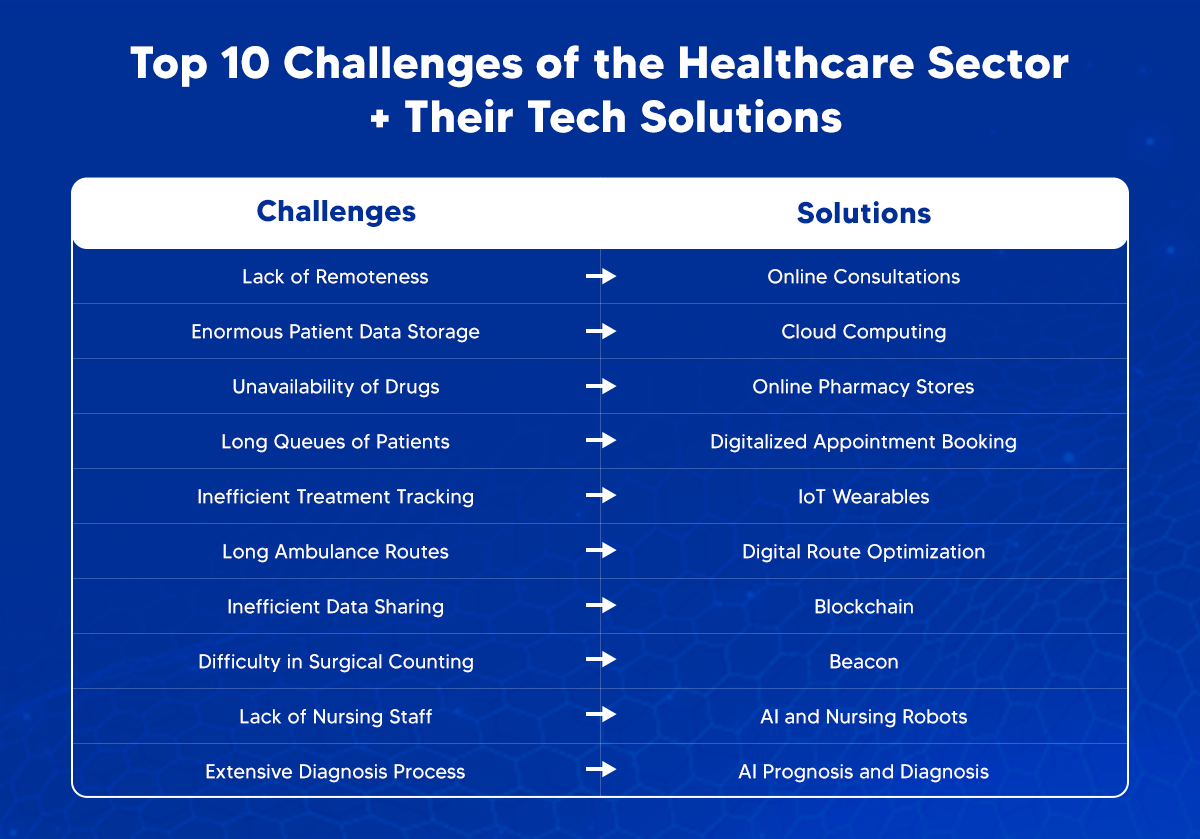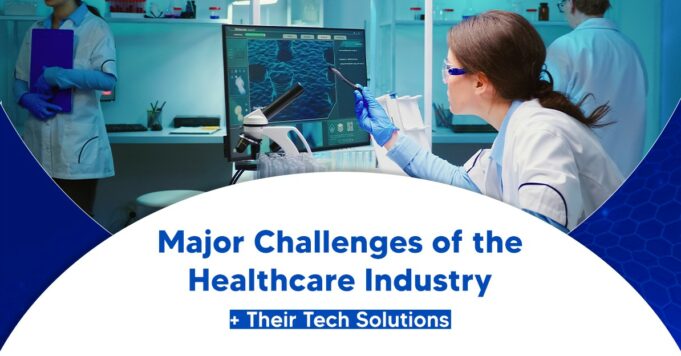Today, the healthcare industry is facing numerous challenges, most of which are due to inefficiency and lack of innovation. While there are a few healthcare institutions that have innovated over the years and have become smart, others still operate with age-old conventional approaches.
However, for the healthcare industry to remain efficient, it is essential to evolve and innovate from time to time. This innovation enables healthcare institutions and practitioners to enhance the quality of their services and increase people’s overall standard of living.
Utilizing technology for this purpose is a billion-dollar idea, as present-day technology is synonymous with efficiency and innovation. This blog will provide detailed information on various challenges that the healthcare sector faces in 2022 and the ways in which technology can enable the industry to ease these challenges. However, let’s start the blog by understanding the basics, i.e., the scope of digital technology in the healthcare sector.
Healthcare Technology in 2022

The healthcare sector has taken a leap recently and has advanced in its practices and processes owing to the vast implementation of technology. Medical practitioners, as well as healthcare institutions, have embraced technology with open arms and have started integrating it into their practice.
This is a major change from conventional medicine to modern one, which is tech-centric and innovative, and, therefore, more efficient than its traditional counterpart. Today, most healthcare services are digitalized in one way or another, proving the tremendous scope of digital technology in the healthcare sector.
Moreover, the use of technology is not only limited to digitalizing the existing operations and processes but extends to enabling healthcare institutions and practitioners to solve the various challenges that the industry faces in 2022.
The upcoming section will provide a detailed view of the major challenges that the healthcare industry faces at present and how technology can help overcome these challenges.
Challenges of the Healthcare Industry and How Technology Can Help

Challenge #1: Lack of Remoteness
It is commonly known, even in the present time, the idea of consulting with a physician is limited to visiting a clinic/hospital in person and meeting the healthcare provider. However, it cannot be denied that visiting a hospital or a clinic is not always a possibility for patients, especially those facing issues with mobility.
Moreover, sticking to conventional practices limits the accessibility of healthcare services to the urban population, therefore, excluding those who live far from hospitals and clinics. This lack of remoteness is often a challenge for the patients, as it isn’t possible to visit a hospital at all times.
Online Consultations
Online consultations have proven to be a great alternative to traditional in-person consultations. This concept enables patients to consult with physicians remotely from anywhere in the world and get treatment for their ailments.
Moreover, online consultation has also brought the global healthcare industry closer than ever before. This is because owing to digital technology, patients can now consult with physicians from different countries and avail their treatment. This also gives the patients more control over the physicians who they wish to be treated from and enhances their overall experience with the healthcare sector.
Challenge #2: Enormous Patient Data Storage
A large number of patients visit healthcare institutions every day. All of these patients provide their vital information during the consultation process, which forms the foundation of their medical records and history. Physicians use this medical history to determine the scope of future treatments and use it to keep track of the patient’s health from time to time.
However, it is commonly known that managing the records of each and every patient is often a challenge for healthcare institutions, especially the ones that operate on a large scale and consult hundreds, if not thousands, of patients every day. As a result, the hospital cabinets are often filled right up to the top with patient files and require a lot of maintenance and management.
Cloud Computing
Technologies like cloud computing are known for their potential to digitalize data storage and make their its management an effortless process. Healthcare institutions can use this technology and store the patient’s data on digital clouds, therefore eliminating the need for physical storage.
Today, healthcare institutions can store an enormous size of data on these digital clouds and avoid piling up files in their cabinets. Moreover, this digitally stored patient data is easy to manage, making it an excellent alternative to conventional data storage.
Challenge #3: Unavailability of Drugs
Certain healthcare conditions require continuous treatment, which includes having a strict drug schedule. However, this is not a possibility at all times due to the limited availability of drugs for certain patients. This often results in compromised treatment efficiency and limits the availability of healthcare services.
To elaborate, while many times the drugs are not available in certain pharmacy stores, others are just out of stock for a certain time. The patients have to hop from one pharmacy store to the other in order to find the prescribed drugs. At last, it is the patient that has to suffer due to the compromised efficiency of the treatment.
Online Pharmacy Stores
One of the best ways to ensure the optimal availability of drugs is to use online pharmacy stores. These stores are a marketplace of different pharmacies and have a enormous list of medicines that are available in the pharmacy stores. The patients can either buy the drugs online (e-pharmacy) or visit the enlisted stores for store pickup.
This enables the patients to stock up on their drugs on time and avoid missing doses, therefore guaranteeing optimal efficiency. Moreover, some online pharmacies also offer high-end features like at-home pathology sample collection and same-day delivery of medicines, further adding to their treatment efficiency.
Challenge #4: Long Queues of Patients
Owing to the increasing number of healthcare concerns, healthcare institutions are witnessing tremendous demand and are seeing more patients than ever in waiting areas and queues. Managing a large number of patients is often challenging for the hospital staff, especially in healthcare institutions with limited space and staff availability.
This is often frustrating for the patients as well, as they have to stand in queues for a long time, that too in sickness. One way to overcome this challenge is to book consultations in advance over phone calls, but this process is often prone to human errors and mismanagement, causing hurdles in healthcare processes and operations.
Digitalized Appointment Booking
One way to facilitate seamless appointment booking and management is to develop a doctor appointment booking application. These mobile apps are highly useful for booking a consultation with a physician and are a useful solution for patients as well as hospital staff.
With these doctor appointment booking applications, physicians can keep flawless track of upcoming appointments and plan their schedules accordingly. Moreover, certain applications also enable patients to reschedule and cancel appointments and even provide certain initial information on their concerns.
This makes doctor appointment booking apps an all-rounded solution for healthcare institutions struggling with long patient queues and an unmanageable number of upcoming appointments.
Challenge #5: Inefficient Treatment Tracking
One of the most important parts of healthcare treatments is tracking the patients and ensuring that they are following the recommended course of treatment. This can include taking medicines on time, doing exercises, taking the right nutrition, etc.
However, it is practically impossible for physicians to track each and every activity of a patient, as it would require being with them at all times. In this case, the physicians often struggle with the limited information they have on patients’ activities, which often compromises the efficiency of the treatment.
IoMT Wearables
Healthcare institutions can use high-end technologies like the Internet of Medical Things (IoMT) and facilitate seamless tracking of patients’ activities. These are wearable devices that are interconnected through sensors and the internet and have the capability to precisely track the patient’s activity.
IoMT wearables are capable of tracking numerous aspects of a patient’s health, from their daily activity to medicine intake, nutrition, and vitals like heart rate, glucose levels, blood pressure, stress level, etc. Moreover, numerous IoMT devices are connected with other technologies like cloud computing for efficient storing of this patient data, which is further used by healthcare practitioners for diagnosis and treatment planning.
Challenge #6: Long Ambulance Routes
Ambulance services play a vital role in the healthcare sector and are useful for providing quick access to healthcare facilities for a patient. This aspect of ambulances makes them useful for managing healthcare emergencies and saving the lives of patients, as even during their transit to the hospital, patients get access to high-end healthcare services from paramedics.
However, it is commonly known that the efficiency of ambulances is limited to the time they take to transit the patient to the hospital for efficient medical treatment by a physician. This is often a challenge as many times the transit is delayed due to road blockages and traffic. This puts the patient’s life at risk and limits their access to healthcare services.
Digital Route Optimization
Digital technologies like IoT have the capability to optimize the route of the ambulance and cut down on transit time. To explain, these technologies are capable of determining different routes for transferring patients to the hospital and can select the route with the shortest travel time.
Moreover, certain digital technologies are also capable of locating the nearest hospitals and clinics. This feature is also useful in optimizing transit time and improving the overall efficiency of the healthcare sector.
Challenge #7: Inefficient Data Sharing
Earlier, we discussed how it is challenging for healthcare institutions to store patient data and manage it efficiently. Another noteworthy drawback of manually storing patient data is undoubtedly increased hurdles in information sharing.
To explain, it is highly challenging for healthcare workers to share patient data and records from one place to another and from one physician to the other. Moreover, manual data storage and sharing comes with the risk of data loss and misuse, which makes it a highly risky process altogether.
Blockchain
Blockchain technology facilitates seamless digital storage and sharing of information on a decentralized network. The data is stored in individual blocks and is highly secure, therefore maintaining its integrity.
This technology has tremendous potential in the healthcare sector and can take storing and sharing patient data to the next level of efficiency. Physicians and healthcare institutions can easily share patient data and records from one location to another on a digital network and guarantee its security.
Moreover, blockchain technology is known for imparting high accountability to data storage, and therefore it is easy to track access and alterations to patient data with ease.
Challenge #8: Difficulty in Surgical Counting
Surgeries play an important role in healthcare services and are widely used to treat numerous healthcare concerns. One of the major parts of conducting a surgery is surgical counting, a process in which the healthcare staff keeps a record of the number of instruments available before and after the surgery.
Surgical counting is highly essential for healthcare institutions as there have been numerous cases of medical negligence where the surgical instruments have been left inside the patient’s body and have caused major disasters.
However, it is commonly known that counting each and every instrument and keeping an accountable record of it comes at the expense of high time requirements.
Beacon
Beacon technology is highly intelligent and is capable of automating the most complex of challenges, especially the ones that otherwise require a lot of manual effort when conducted conventionally.
Beacon-based healthcare solutions are capable of automating surgical counting, recording the figures, and storing them for optimal accountability. This technology eliminates the chances of human error and reduces the human resource requirement for the process.
Challenge #9: Lack of Nursing Staff
Like many other industries, the healthcare industry is suffering from the limited availability of human resources. Present-day healthcare institutions are suffering due to high market demand and low availability of nursing staff to take care of the patients.
This is setting the healthcare industry under tremendous pressure, as now there is less staff to take care of the patients. Moreover, in many cases, healthcare institutions have to suffer due to the high costs of hiring and maintaining a team of nursing staff, which can be economically unfeasible at times.
AI and Nursing Robots
Artificial intelligence and nursing robots are great alternatives to human nursing staff. These tech-based nursing solutions are highly smart and are capable of taking good care of the patients.
AI solutions are often combined with other smart technologies like IoMT wearables and are a complete solution for nursing patients. These wearables are as good as real-life nursing staff and are highly capable of offering services similar to those of nursing personnel.
Nursing robots, on the other hand, are a more advanced form of nursing technology and are useful for offering more advanced forms of nursing services. These robots can do everything and anything, from providing medicine doses at prescheduled times to checking patients’ vitals by themselves.
Challenge #10: Extensive Diagnosis Process
Diagnosing a patient is one of the primary stages of offering healthcare services. This stage forms the foundation of further treatment and is therefore highly crucial.
As a result, physicians take medical diagnosis very seriously and practice a prolonged diagnosis process that often includes different physical and pathological examinations, checking the patient’s vitals, examining medical history, and a lot more.
Naturally, medical diagnosis is a time-consuming step and a hurdle between the limited availability of healthcare service providers and the high demand for healthcare services.
AI Prognosis and Diagnosis
Artificial intelligence and machine learning are highly useful technologies to facilitate seamless and precise medical diagnosis and prognosis. To explain, these technologies are highly intelligent and are capable of not only examining the patient’s vitals but also offer a primary medical prognosis.
Based on further examinations and patient data, these technologies can offer an efficient diagnosis and also provide potential treatment options based on the diagnosed concerns. It is worth noting that even though AI technology is highly smart, it cannot replace a physician’s expertise and experience.
Therefore, this technology in no way can replace visiting a physician but can be used by healthcare institutions to make the physician’s work easier by ruling out certain possibilities and scopes in treatment.
These were a few of the many ways in which the healthcare sector can use technology to overcome its challenges and become more efficient.
Summing It Up
The present-day healthcare industry is facing numerous challenges, the most prominent of which is the high demand for healthcare services and the limited availability of healthcare service providers. In this case, it is in the best interest of healthcare institutions as well as practitioners to become more efficient in their practices.
One way to achieve this objective is to utilize technology for the matter and implement tech-based digital solutions that help in automating healthcare processes. The blog provided numerous instances and examples that prove the tremendous scope of digital technologies in aiding the challenges that the healthcare industry faces.
All that a healthcare institution needs to do now is determine the scope of technology in its operations and integrate processes that are based on this scope. This will ensure optimal utilization of technology and will guarantee seamless growth of the healthcare industry.












